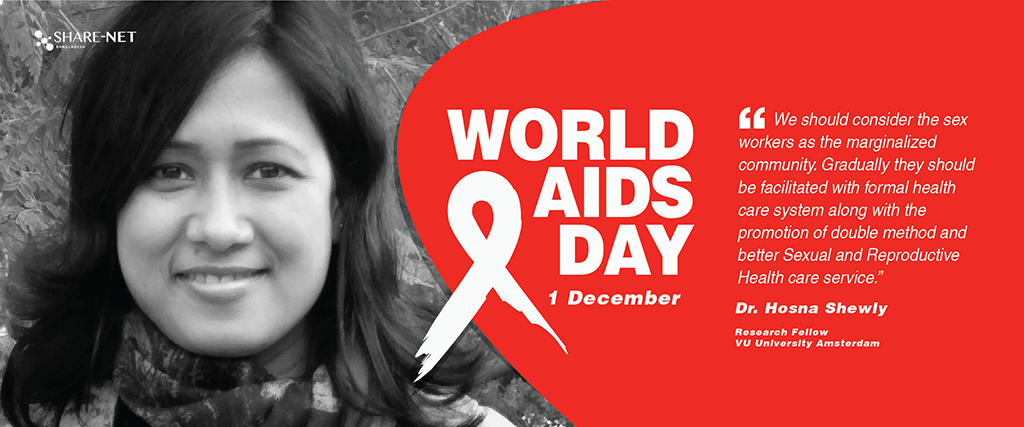Sex workers should be included in the formal health care system
According to WHO about 20.9 million people are receiving HIV treatment in the mid-2017. Though the progress has been made to reduce the transmission of the disease, the risk of having HIV virus is still prevalent among the sex workers in the country. On the World AIDS Day 2017, Share-Net Bangladesh has a discussion with Dr. Hosna Shewly, Research Fellow, VU Amsterdam on the existing problem and probable solutions to mitigate the risk of transmitting HIV virus among the urban based female sex workers in Bangladesh.
As part of their research ‘Migration, Livelihoods and SRHR: A Triple Case Study at Dhaka’, they found most of the urban based sex workers come from the impoverished background and most of them are internal migrants. A majority of them come in the city for work while some others are newly married and sold by their husband or boyfriend. Generally, residents based sex workers receive 4/6 clients daily. Sometimes they choose their clients or the gharwali (landlady) arranges the customer for them.
An estimated amount of sex workers for 17% are adolescent and their sexual health is at risk, according to other research. In their research, Dr. Shewly found most of their respondents have experienced unintended pregnancy and often have uterus infection. A majority of them are not either aware of proper precaution or they are not in a situation to take any precaution. Sex workers generally buy condoms from the NGOs working for the prevention of HIV/AIDS. As part of the prevention of HIV/AIDS, the government and NGOs work together and established Drop in Centers for awareness building, HIV test, STD/STI test and day time rest room. If someone is HIV positive, they are sent to the ‘Ashar Alo’ for council ingredients and treatment.
The independent sex workers working for long term are more aware about the sexully transmitted disease than the new one. The experienced sex workers are more aware about the sexually transmitted disease. They prefer to use condom for the safety as well as contraception. But still about 60% cases it is possible for the sex workers to convince the clients to take condom. The lack of awareness among the clients are high. The new and young sex workers are specifically less aware about their health risks.
To improve the reproductive health condition of the sex workers, we should consider them as marginalized group and advocate for their rights. ‘We should consider the sex workers as the marginalized community rather than thinking them as vector of disease. They only get attention as part of HIV/AIDS prevention. Their basic human rights are violated in most of the times. We found they need special attention for their SRH needs. Perhaps, building one stop service combining SRH service alongside the DIC services could be a good initiative. For protection against both unwanted pregnancy and STI, it is necessary to begin the promotion of ‘double protection methods ‘ for sex workers’ better Sexual and Reproductive Health care’ says Dr. Shewly.


